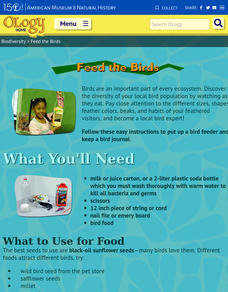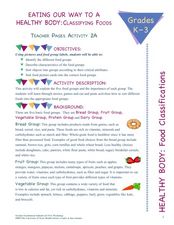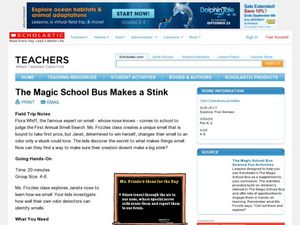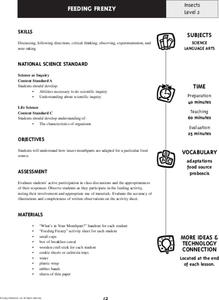Curated OER
Fortified Breakfast
Students reverse engineer a cereal. In this dietary lesson students identify the minerals that the human body needs to function. Students examine how foods are fortified by food engineers. Students find the amount of iron in a cereal by...
Exploratorium
Breakfast Proteins - Construct a Protein through Cereal Additions
Match my cereal sequence. Pupils view a sequence made by colorful cereal rings and create copies of it. Learners must either remember or write down the sequence to transport the code to another location. Scholars replicate the cereal...
Curated OER
Iron For Breakfast
Third graders are challenged to use scientific thinking, they experiment and observe which objects are attracted to a magnet. Pupils use the evidence to construct an explanation as to what common property the objects attracted to a...
Baylor College
Energy Sources
Take the concept of burning calories to a more literal level in the second of seven lessons about energy in the realm of food and fitness. Using simple materials, groups will burn breakfast cereal and a pecan to see which one gives off...
Curated OER
Iron in Cereal
Students use a small magnet to remove particles of iron from common breakfast cereal.
Curated OER
SCRUMPTIOUS SOIL
Students engage in investigations that lead to the discovery that earth materials consist of rocks, soils, water, and air. They build models of soil profiles, using breakfast cereal and other edible materials. They observe how water...
Curated OER
Don't Worm Your Way Out of This One!
Students study different aspects of worms along with the process of vermicomposting by participating in a class experiment to study the time it takes for breakfast cereal to be eaten by worms.
Curated OER
Introduction To the Classification of Organisms
Learners discuss how scientists classify organisms. In pairs, they analyze and label "specimens" of breakfast cereals in order to classify them into the correct group. They create a dichotomous key for several species of animals.
Curated OER
The Young Virginia Gardener: Growing Seeds Indoors: Seeds for Breakfast
In this gardening worksheet, students answer a set of questions about seeds eaten form breakfast in cereals, 10 questions total.
Curated OER
Fit With Fiber
Sixth graders investigate the nutritional value of different types of cereal. They take a survey of students that ate breakfast and create a circle graph with the results. Students examine the nutritional information on the sides of the...
Curated OER
Minerals and You
Students study how mineral are used in everything around us-- from cereal to satellites. After informing the students about minerals they will discuss the ones that are in the area of the students.
Curated OER
Feeding Frenzy
Young biologists take a look at the myriad of ways that animals increase their chances of surviving in the wild. The adaptations help animals hide, hunt, and attract a mate. This lesson specifically explores how insect mouth parts are...
Baylor College
Serving Sizes
Are serving sizes for different foods always appropriate for what you need? In this hands-on activity, learners work in groups to estimate what one serving size of various foods are, and then evaluate their hypotheses by measuring...
Curated OER
Redox Titration of Iron
Students perform a redox titration of iron. In this iron titration lesson plan, students use potassium permanganate to oxidize iron so they can determine the percentage of iron in a sample of fertilizer.
Nuffield Foundation
How Much Energy Is There in Food?
People associate calories with food, but what is a calorie? Young scientists measure the number of calories in samples of food to better understand the concept. They test a variety of samples, take measurements, and compare their results...
American Museum of Natural History
Feed the Birds
What kinds of birds are common in the area? Young scientists use household supplies to create bird feeders. They then document the birds that come to their feeders by keeping journals.
American Museum of Natural History
Feed the Birds
Scholars use a large carton, string, an emery board, and bird food to create a hand-made bird feeder. After completing the craft, pupils keep a journal to track their observations.
Curated OER
The Elements
Fifth graders explore the differences between elements. In this elements and atoms lesson students complete an activity that shows how chemicals react to a flame test.
Curated OER
Eating Our Way to a Healthy Body: Classifying Foods
Students examine the major food groups. In this classifying foods lesson plan, students discover the 5 food groups as they read books and play games. Students then sort foods into the appropriate food groups
Curated OER
Economics: What Are Some Other Uses for Rice?
Sixth graders investigate ways rice is sold by creating a chart of the different rice foods. In this economics lesson, 6th graders examine their local food store and list at least 10 rice by-products in a class chart. Students discover...
Curated OER
The Magic School Bus Makes a Stink
Students learn along with Ms. Frizzle's class. In this Magic School Bus lesson plan, students discover the secret to what makes things smell through their own investigations.
Curated OER
Biological Molecules
Ninth graders examine the structure and function of biomolecules. In this food molecule lesson plan, 9th graders will examine various types of biomolecules such as carbohydrates, lipids, proteins, and nucleic acids. They will...
Curated OER
Going My Way?
Students, in groups, study how a magnet works and how people use the Earth's magnetic field to orient themselves.
Curated OER
Feeding Frenzy
Students examine, through experimentation and simulation, how insect mouthparts are adapted for particular food sources, discuss how various animals have adapted to survive, play Feeding Frenzy game, and complete activity sheets.
Other popular searches
- Breakfast Cereal Grains
- Marketing a Breakfast Cereal
- New Breakfast Cereals
- Nutrition Breakfast Cereal
- Chocolate Breakfast Cereal























